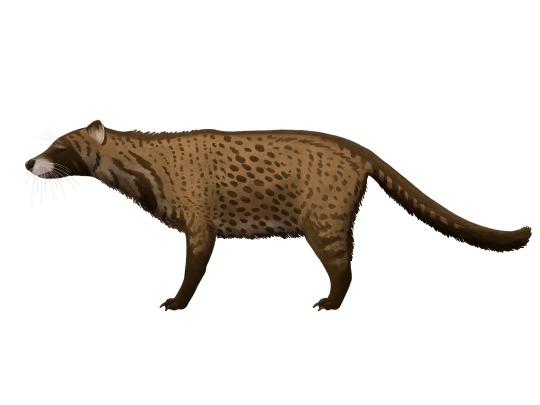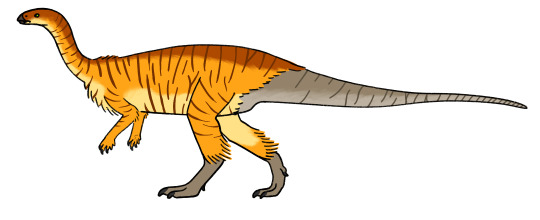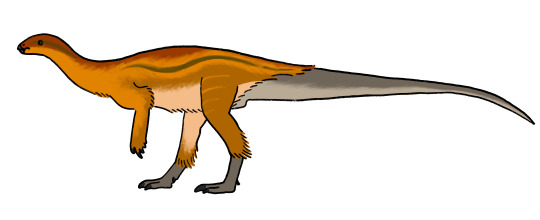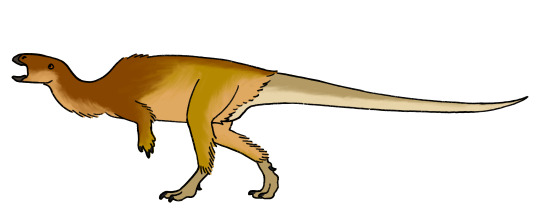Dedicated to the long-extinct creatures humanity has forgotten. All art is my own unless otherwise stated.
Last active 60 minutes ago
Don't wanna be here? Send us removal request.
Text
Vishnuictis

Vishnuictis was a genus of viverrid from the Middle Miocene to Pleistocene. Its type species is V. durandi. Its other known species are V. africana, V. chinjiensis, V. hariensis, V. hasnoti, V. hinduiensis, V. plectilodous, V. salmontanus, and V. yuanmouensis. Its known specimens were found across Africa and South Asia in various formations in Kenya, China, Pakistan, and India. Vishnuictis is currently the largest member of its family.
Vishnuictis is primarily named after the Hindu deity Vishnu. The latter half of its name mean "marten" in Greek. V. africana is named after its discovery in Africa, the only Vishnuictis species to date to be found there. V. plectilodous combines "plectilo" for the complex shapes of its teeth and "odous" for tooth.
Vishnuictis is known from several fossils, including a full and a partial skull, several mandible fragments, and many teeth. Its autapomorphies include extreme height and slenderness of the skull that sets it apart from all modern viverrids.

Due to the size of its known fossils, it is thought that Vishnuictis is much larger than modern viverrids. It likely was around the size of or larger than the average modern wolf. New material from 2025 suggests that it may have also had an omnivorous diet.
Originally, V. durandi was described in 1884 as a member of Viverra before later being assigned to Vishnuictis in 1932. V. chinjiensis was also assigned to Viverra in the same 1932 paper, but was later reassigned to Vishnuictis as well. The placement of Vishnuictis within viverrids has not been well-examined, but it is thought to be most closely related to the modern Viverra.
Sources: Pilgrim 1932 (p 101-108), Werdelin 2010 (p 624), Sankhyan 2025
#vishnuictis#viverridae#feliformia#carnivora#mammalia#mammal#paleoart#paleontology#prehistory#obscure fossil animals#obscure fossil mammals
30 notes
·
View notes
Text
hey folks ! apologies for my disappearance; college got super busy so i had to abandon the blog for a while.
it's summer break now tho, so i have plenty of time to work on art! i'll be making a new post within the next day. afterwards i'm hoping to move to a posting schedule of at minimum once every two weeks, at least for the summertime. this schedule may change during the fall, but i'll keep you all more updated this time :) keep an eye out!
2 notes
·
View notes
Text
Achanarella

Achanarella was a genus of jawless fish from the Middle Devonian. Its type and only known species is A. trewini. Its known specimens were found in the Achanarras Quarry of Scotland. Despite being known since the 1980s, it was not formally named until 2002.
Its name Achanarella refers to its locality, the Achanarras Quarry. The species name trewini refers to Nigel Trewin, a paleontologist that has done a great amount of work at the quarry for decades.
Achanarella is known from many specimens, though their preservation quality is usually quite poor. The holotype is the best-preserved fossil that has been found to date that has many distinguishable anatomical features. However, the slab the holotype is on has a plant stem crossing through the center, leaving some features unidentifiable.

In life, Achanarella would be a slender and small fish. The largest specimens are about 90mm and the smallest reach about 20mm. The eyes are large and conspicuous, especially with the small head. The mouth appears on the fossils as just a round hole without any obvious features inside. A caudal fin and anal fin are present, and possibly a dorsal fin. There are at least 13, or possibly more than 20, branchial (gill) openings beginning right behind an eye. Achanarella was likely similar looking to a modern lamprey.
Though no notochord is visible, it's likely Achanarella was a vertebrate due to its overall appearance and the presence of epichordal fin supports, a feature many other primitive vertebrates from the time period share. The exact taxonomy of Achanarella beyond that is uncertain, but it was placed into its own family Achanarellidae, which is under Jamoytiiformes.
Sources: Newman 2002
#achanarella#achanarellidae#jamoytiiformes#jawless fish#osteichthyes#chordata#paleoart#artwork#paleontology#original art#human artist#obscure fossil animals#obscure fossil chordates
32 notes
·
View notes
Text
Collinsium ciliosum

Collinsium was a genus of luolishaniid from the Early to Middle Cambrian. Its type and only species is C. ciliosum. Its known specimens were found in the Hongjingshao Formation in China.
Collinsium honors Desmond Collins, an invertebrate paleontologist who has contributed significantly to the field, including figuring out Anomalocaris's real appearance. The species name, ciliosum, means "hairy" in Latin.

There are several known specimens of Collinsium, which are all in great condition and preserve many soft tissues and sensory hairs. The animal reached around 85mm in length. Its body has 15 sets of biomineralized sclerites, which are composed of spines of various lengths that increase in size towards the center of the body. Besides the first set, each row is comprised of five spines. It has six long appendages near the head that each have roughly 30 bristle-like spines. The rest of the limbs are shorter and spineless, instead ending with a small hooked claw. The front section of the body is covered densely in hairs which become much sparser after the sixth appendage pair.
Collinsium is unique among lobopodians, as most are known to have sclerite sets comprised of only one pair of spines or plates. It also would have been subject to more to visual predation than its relatives given its extravagant armor. It was recovered as a member of Luolishaniidae, a clade of superarmored lobopodians, due to its similarity to Luolishania and Collinsovermis.
Source: Yang 2015 (Original Description)
#collinsium#luolishaniidae#lobopodia#onychophora#panarthropoda#invertebrates#paleoart#paleontology#artwork#original art#human artist#obscure fossil animals#obscure fossil chordates#trying something new with the layout... hope u all like it :)
21 notes
·
View notes
Text
Hi guys! Wanted to update a bit on why it's been pretty quiet. Don't worry, nothing bad.
I am currently restructuring the way I research data to make it more efficient and well-documented (e.g. preventing myself from researching animal groups I've already researched a hundred times) and I am also still moving back into my house from college so I have to deal with that before I'm really able to use my desk to draw and stuff like that. It'll take some time but in hopefully a few weeks at most you should see more creatures getting posted more frequently, at least for the summer.
This blog doesn't have too much of a following but everyone here has been wonderfully supportive and I really appreciate it <3 catch u all later with lots of new animals to share !!!
0 notes
Text
Tapinocaninus

Tapinocaninus was a genus of tapinocephalid therapsid from the Middle Permian. Its type and only species is T. pamelae. Its known specimens were found in the Karoo Supergroup in South Africa. Tapinocaninus is the largest known therapsid from the Guadalupian Period.
The generic name Tapinocaninus means humble (tapino) canine (caninus). The specific name pamelae was named for Pam Rubridge, the mother of the original describer, Bruce S. Rubridge. She was on the field when he discovered the first fossils.
Most known Tapinocaninus fossils consist of skulls, though its spine of 36 vertebrae, several ribs, pectoral and pelvic girdles, three humeri, and a femur have been discovered. Its autapomorphies include a relatively large temporal opening, only having two sacral vertebrae, only seven caudal vertebrae, a notably high amount of vertebral intercentra, an anterior coracoid included in the glenoid, which is straight and facing posteroventrally, and the lack of ectepicondylar foramen.
Tapinocaninus has been recovered as the most basal member of Tapinocephalidae, as it has both derived dinocephalian features and ancestral features of sphenacodonts. Tapinocephalidae itself is the most derived family of Dinocephalia.
Original paper: Rubridge 1991, Postcranial materials description 2019
Wikipedia article: here
#tapinocaninus#tapinocanininae#tapinocephalidae#dinocephalia#therapsida#therapsids#paleoart#paleontology#original art#human artist#artwork#obscure fossil animals#obscure fossil therapsids
19 notes
·
View notes
Text
Iberica hahni

Iberica was a genus of multituberculate mammal from the Early Cretaceous Period. Its type and only species is I. hahni. Known specimens were found in the El Castellar Formation in Galve, Spain. While the fossils assigned to Iberica have been known since the 1960s, they were not officially named until 2011.
The name Iberica comes from the fossil's location on the Iberian Peninsula. The specific name hahni was named in honor of Gerhard and Renate Hahn for their research on Iberian Peninsula multituberculates.
Known fossils of I. hahni include seven P1/3s (premolars), which are the type specimen, as well as the referred material of a P4 fragment (premolar) and two M2s (molars). Its autapomorphies include the four cusps on its premolars, as compared to three cusps from related genera, as well as cuspules on the mesial and distal margins.
The material assigned to I. hahni, especially the referred P4 and M2s, cannot be certainly assigned to either Eobaataridae or Plagiaulacidae. The type premolars are similar to that of Parabolodon elongatus and Eobaatar? pajaronensis. The P4 fragment is also very similar to that of Cheruscodon balvensis. The tentative assignment to Eobaataridae seems somewhat unlikely.
References: Original description by Ainara Badiola, José Ignacio Canudo, and Gloria Cuenca-Bescós; cladistic assessment by Thomas Martin et al.
Wikipedia article: Iberica hahni
#mammal#mammalia#paleoart#paleontology#artwork#original art#human artist#iberica#eobaataridae#plagiaulacidae#plagiaulacida#multituberculata#obscure fossil animals#obscure fossil mammals
19 notes
·
View notes
Note
If you want a really, really obscure genus to draw how about Portezueloemys? It's a genus of turtle that doesn't even have a wikipedia page.
looks neat ! another one to add to the reptile (and article-less) pile :)
0 notes
Text
art updated for accuracy :)
Talenkauen santacrucensis

Talenkauen was a genus of neornithischian dinosaur from the Late Cretaceous period. Its type species is T. santacrucensis. The only specimen was found on Los Hornos Hill on the coast of Viedma Lake in Patagonia, Argentina. This specimen was found lying next to a scattering of fragmentary bones and teeth, which has been identified as a recently-hatched baby T. santacrucensis.
Talenkauen means "small skull;" its root words "talenk" and "kauen" originate from the Aonikenk language.
Its autapomorphies include a well–developed epipophysis on cervical 3 and plate–like unicate processes on the rib cage.
Talenkauen was a bipedal herbivorous dinosaur. It was at most 4 meters long, with a similar build to Dryosaurus, having short limbs, a long trunk and neck, and a small head. It was found to be closely related to Macrogryphosaurus and the clade Elasmaria was erected for the two genera. As of 2019, Elasmaria now includes almost a dozen genera.
Original paper: Novas, Fernando E.; Cambiaso, Andrea V; Ambrioso, Alfredo (2004). "A new basal iguanodontian (Dinosauria, Ornithischia) from the Upper Cretaceous of Patagonia". Ameghiniana. 41 (1): 75–82.
Wikipedia article: https://en.m.wikipedia.org/wiki/Talenkauen
21 notes
·
View notes
Text
art updated for accuracy :)
Isasicursor santacrucensis

Isasicursor was a genus of neornithischian dinosaur from the Late Cretaceous period. Its type species is I. santacrucensis. The first specimen was found in the Chorillo Formation in Patagonia, Argentina in 2019. About 16 other specimens were referred to the genus, representing at least 4 individuals.
Isasicursor means "Isasi's runner," referring to Marcelo P. Isasi, the species' discoverer.
Its autapomorphies include a ventrally curved sacrum, peg-and-socket articulation between the first and second sacral vertebrae, the tibia's cnemial crest is proximally projected and thickened, the tibia has an additional anterolateral process on the lateral condyle, and metatarsal II has a proximally displaced indent for a ligament on its lateral surface.
Isasicursor was a bipedal herbivorous dinosaur. It would have been around 4 meters long. While there have been no further cladistic analyses performed, it was initially placed in Elasmaria, which, if correct, would make it the youngest known ornithopod from South America.
Original paper: Novas, F., Agnolin, F., Rozadilla, S., Aranciaga-Rolando, A., Brissón-Eli, F., Motta, M., Cerroni, M., Ezcurra, M., Martinelli, A., D'Angelo, J., Álvarez-Herrera, G., Gentil, A., Bogan, S., Chimento, N., García-Marsà, J., Lo Coco, G., Miquel, S., Brito, F., Vera, E., Loinaze, V., Fernandez, M., & Salgado, L. (2019). Paleontological discoveries in the Chorrillo Formation (upper Campanian-lower Maastrichtian, Upper Cretaceous), Santa Cruz Province, Patagonia, Argentina. Revista del Museo Argentino de Ciencias Naturales, 21(2), 217-293.
Wikipedia article: https://en.m.wikipedia.org/wiki/Isasicursor
Tags: #dinosaur #dinosauria #paleoart#paleontology#artwork#original art#human artist#[genus] #[family/clade] #[family/clade] #[family/clade] #obscure fossil animals
10 notes
·
View notes
Text
art updated for accuracy :)
Notohypsilodon comodorensis

Notohypsilodon was a genus of neornithiscian dinosaur from the Late Cretaceous period. Its type species is N. comodorensis. The only specimen was found in the Bajo Barreal Formation in Chubut, Patagonia in 1985. The specimen in question has been identified as a juvenile due to the fact its neural arches are not fused to the body of the vertebrae.
Its autapomorphies include the femur's lateral margin of the greater trochanter is sigmoidal in shape, with a thick posterior edge and a very thin anterior edge, as well as, the proximal end of metatarsal IV has a thick and very well-developed posterior process that medially wraps metatarsal III.
The holotype consists of four neck, seven back, five hip, and six tail vertebrae, four rib fragments, a partial right coracoid, a partial left scapula, a right humerus, both ulnae, a right fibula and astragalus, a left femur, tibia, fibula, partial astragalus, and calcaneum; and thirteen phalanges.
Notohypsilodon was a small bipedal herbivore. It would most likely have been around 1-2 meters long. It was originally classified as a hypsilodont, hence its name, but was later found to be too fragmentary to be classified past Euornithopoda. A study in 2015 classified it as part of Elasmaria, a basal ornithischian clade.
Original paper: Martínez, Rubén D. (1998). "Notohypsilophodon comodorensis, gen. et sp. nov., un Hypsilophodontidae (Ornithischia: Ornithopoda) del Cretacico Superior de Chubut, Patagonia central, Argentina". Acta Geologica Leopoldensia (in Spanish and English). 21 (46/47): 119–135.
Wikipedia article: https://en.m.wikipedia.org/wiki/Notohypsilophodon
9 notes
·
View notes
Text
art has been updated for accuracy :)
Changchunsaurus parvus

Changchunsaurus was a genus of neornithischian dinosaur from the Cretaceous period. Its type species is Changchunsaurus parvus. The only specimen was found in the Quantou Formation of the Songliao Basin in 2005. It is the first dinosaur found in the Jilin province of China.
Its autapomorphies include a slit-like incisive foramen present on the midline of the premaxillary palate, medial to crowns three and four, with foramen positioned lateral to it on each side; a thickened and slightly rugose dorsolateral surface of the dentary, continuous to the predentary; and a groove extending rostromedially along the lateral surface of the caudal half of the dentary and onto the medial surface of the coronoid process.
It is not exactly known where Changchunsaurus sits amongst other neornithischians, but it has been found to be closely related to Jeholosaurus and Haya. It is known from the holotype that includes the skull, the axial column as far as the cranial end of the sacrum, and partial forelimbs and hind limbs. Only the skull is described in its original paper. It may also be known from additional material found in the Quantou Formation, some of which was described and referred to the genus in 2010.
Original paper: Zan Shu-Qin; Chen Jun; Jin Li-Yong; Li Tao (2005). "A primitive ornithopod from the Early Cretaceous Quantou Formation of Central Jilin, China". Vertebrata PalAsiatica (in Chinese and English). 43 (3): 182–193.
Referred specimen paper: Jin Liyong; Chen Jun; Zan Shu-Qin; Richard J. Butler & Pascal Godefroit (2010). "Cranial anatomy of the small ornithischian dinosaur Changchunsaurus parvus from the Quantou Formation (Cretaceous: Aptian–Cenomanian) of Jilin Province, northeastern China". Journal of Vertebrate Paleontology. 30 (1): 196–214. doi:10.1080/02724630903412372
Wikipedia article: https://en.m.wikipedia.org/wiki/Changchunsaurus
29 notes
·
View notes
Text
art has been updated for accuracy :)
Nevadadromeus schimtti

Nevadadromeus was a genus of neornithischian dinosaur from the Late Cretaceous period. Its type species is Nevadadromeus schmitti. The only specimen was found near the Valley of Fire in the Willow Tank Formation in the U.S. state of Nevada in 2008. It represents both the first non-avian dinosaur and the first unique dinosaur known from Nevada.
The specimen was not described or named until 2022, in which it was assigned to Thescelosaurinae. Nevadadromeus is known from fragmentary remains including the proximal femora, several vertebrae without neural arches, ossified tendon fragments, several pedal phalanges, and some other unidentifiable remains.
Original paper: Bonde, Joshua W.; Hall, Rebecca L.; Krumenacker, L. J.; Varricchio, David J. (2022). "Nevadadromeus schmitti (gen. et sp. nov.), a New Basal Neornithischian with Affinities to the Thescelosaurinae, from the Upper Cretaceous (Cenomanian) Willow Tank Formation of Southern Nevada". Journal of the Arizona-Nevada Academy of Science. 50 (1): 1–8. doi:10.2181/036.050.0101. ISSN 0193-8509. S2CID 252931645.
Wikipedia article: https://en.m.wikipedia.org/wiki/Nevadadromeus
7 notes
·
View notes
Text
art has been updated for accuracy :)
Yueosaurus tiantaiensis

Yueosaurus was a genus of neornithiscian dinosaur from the Cretaceous period. Its type species is Y. tiantaiensis. The only specimen was found in the Liangtoutang Formation. It represents the first known basal neornithopod dinosaur from China, and the southernmost known from Asia as a whole.
Its autapomorphies include anteroventral expansion of the scapula that exceeds its posteroventral expansion, the scapula's posterior edge that is almost perpendicular to the shaft, the scapula has a ventroscapular groove, and the scapula also possesses both a supraglenoidal buttress and supraglenoid fossa.
Due to its fragmentary nature, it is impossible to carry out detailed phylogenic analysis. However, it is identifiable as a neornithischian dinosaur, most likely closely related to Jeholosauridae or Thescelosauridae due to its more basal features. Y. tiantaiensis is known from cervical, dorsal, and caudal vertebrae; scapula, rib, hip bones, and partial forelimb and hindlimb fossils.
Original paper: Zheng, Wenjie; Xingsheng Jin; Masateru Shibata; Yoichi Azuma; Fangming Yu (2012). "A new ornithischian dinosaur from the Cretaceous Liangtoutang Formation of Tiantai, Zhejiang Province, China". Cretaceous Research. 34: 208–219. doi:10.1016/j.cretres.2011.11.001.
Wikipedia article: https://en.m.wikipedia.org/wiki/Yueosaurus
30 notes
·
View notes
Text
art has been updated for accuracy :)
Yandusaurus hongheensis

Yandusaurus was a genus of ornithischian dinosaur from the Middle Jurassic. Its type species is Y. hongheensis. The only specimen was found in Jinzidang near the Honghe dam during construction in 1973. The fossil had been accidentally processed partially through the composter but was still intact enough to work with, and it was formally described in 1979.
A second species, Y. multidens, was named in 1983, but this was later reassigned to Agilisaurus in 1992 and then Othnielia (Nanosaurus) in 1996. Eventually, in 2005, it was described as its own genus as Hexinlusaurus multidens.
The fossil consists of the skull, vertebral column, shoulder girdle, frontlimbs and hindlimb, all of which are heavily damaged. The end of the tail, lower jaws, and pelvis were most likely destroyed in the composter. Y. honheensis was bipedal and likely a fast runner with four toes on its hind legs and five on its front legs. It had large eyes and its teeth showed unique patterns of parallel ridges along them.
Original paper: He, X. "A newly discovered ornithopod dinosaur-Yandusaurus from Zigong, China." Contributions to International Exchange of Geology, Part 2 (1979): 116-123.
Wikipedia article: https://en.m.wikipedia.org/wiki/Yandusaurus
88 notes
·
View notes
Text
art has been updated for accuracy :)
Sanxiasaurus modaoxiensis

Sanxiasaurus was a genus of neornithischian dinosaur from the Middle Jurassic. The only specimen was found in the Xintiangou Formation of Yunyang, Chongqing Municipality, China. It is the oldest known neornithischian from Asia.
Its autapomorphies include at least four sacrals, a laterally bowed humerus, an obturator process located midway on the ischial shaft, a broadened and wing-shaped lesser trochanter of the femur, which is also subequal in anteroposterior width to the greater trochanter; and a distal tibia with elongate posterolateral process.
It is more basal than Lesothosaurus, but more derived than Hexinlusaurus. The holotype fossil consists of 55 postcranial bones, including vertebrae, both humeri, radii, and ulnas, and several leg bones.
Original paper: Ning Li, Hui Dai, Chao Tan, Xufeng Hu, Zhaoying Wei, Yu Lin, Guangbiao Wei, Deliang Li, Li Meng, Baoqiao Hao, Hailu You & Guangzhao Peng (2021) A neornithischian dinosaur from the Middle Jurassic Xintiangou Formation of Yunyang, Chongqing, China: the earliest record in Asia, Historical Biology, 33:7, 1089-1102, DOI: 10.1080/08912963.2019.1679129
Wikipedia article: https://en.m.wikipedia.org/wiki/Sanxiasaurus
6 notes
·
View notes
Text
Sulestes

Sulestes was a genus of deltatheroidean mammal from the Cretaceous Period. Its type species is S. karakshi. The known specimens were found in the Bissekty Formation, Kyzyl Kum desert, Uzbekistan. Sulestes was the first and currently only identified metatherian taxon from the Bissekty Formation.
Its autapomorphies include the first premolar's oblique orientation relative to the dentary, an asymmetrical third molar, the presence of a fourth non-vestigial molar, and a double-rooted first premolar.
Sulestes is known from its holotype, a left maxilla fragment, as well as referred specimens. These specimens were originally labelled under "Deltatherus" and "Marsasia" and consist of a right petrosal, right maxilla, two left maxilla fragments, left coronoid process, several right and left dentary fragments, and a few isolated teeth. Sulestes is recovered as the sister taxon to Deltatheroides and Deltatheridium within Deltatheroida.
Citations: The original description paper, Nessov 1983, is not available online. Nessov and Russell 1994 (description); Averianov, Archibald, and Ekdale 2010 (referred material).
Wikipedia article: here
#mammal#mammalia#paleoart#paleontology#artwork#original art#human artist#sulestes#deltatheroida#metatheria#theria#obscure fossil animals#obscure fossil mammals#obscure fossil tetrapods
14 notes
·
View notes